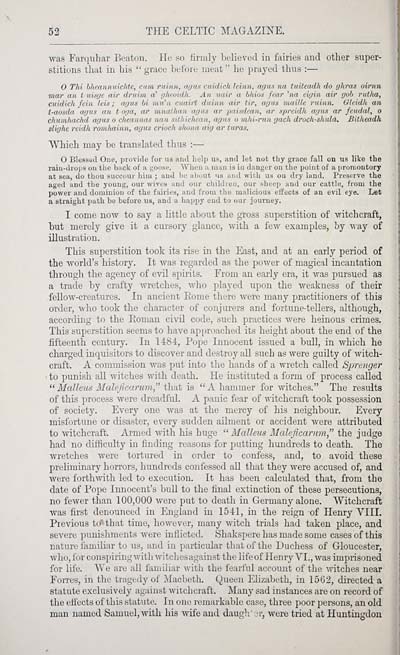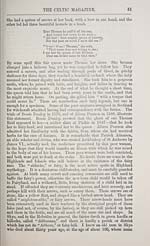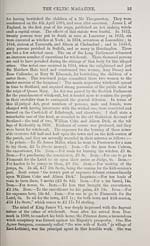Blair Collection > Celtic magazine > Volume 3
(62)
Download files
Complete book:
Individual page:
Thumbnail gallery: Grid view | List view

52 THE CELTIC MAGAZINE.
was Farquhar Beaton. He so lirmly believed in fairies and other super-
stitions that in his " grace before meat " he prayed thus : —
Thi hheannuichte, cum, ruiiin. aiin.^ ruhllch Icinn, agm na tuiteadh do ghras oirnn
mar an t uisge air druim a' glunuili. Afi uuir a bhios fear 'na eigin air gob rutha,
cuidich fein lets; agus bi miCn cituirt duiua air tir, agus maille ruinn. tileidh an
t-aosda agus an toga, ar mnafhaa agus ar paisdean, ar spreidh agus ar feudal, o
chumliMchd agus o cheaiinas nan sithichean, agus o mld-riin gach droch-skula. Bitkeadh
slighe reidh romhainn, agus crioch shona aiy ar turas.
Which may be translated thus : —
O Blesstitl One, provide for us and help us, and let not tby grace fall on us like the
rain-drops on the back of a goose. When a rnan is in danger on the point of a promontory
at sea, do thou succour hiui ; and be about us and with us ou dry land. Preserve the
aged and the young, our wives and our children, our sheep and our cattle, from the
power and dominion of the fairies, and from the malicious effects of an evil eye. Let
a straight path be before us, and a happy end to our journey.
I come now to say a little about the gross superstition of -witchcraft,
but merely give it a cursory glance, with a few examples, by way of
illustration.
This superstition took its rise in the East, and at an early period of
the world's history. It was regarded as the power of magical incantation
through the agency of evil spirits. From an early era, it was pursued as
a trade by crafty wretches, who plaj'ed upon the weakness of their
fellow-creatures. In ancient Eome there were many practitioners of this
order, who took the character of conjurers and fortune-tellers, although,
according to the Eoman civil code, such practices were heinous crimes.
This superstition seems to have approached its height about the end of the
fifteenth century. In 1484, Pope Innocent issued a bull, in which he
charged inquisitors to discover and destroy aU such as were guilty of witch-
craft. A commission M'^as put into the hands of a wretch called Sprenger
to punish all witches with death. He instituted a form of process called
^^ Malleus Maleficarum," that is "A hammer for witches." The results
of this process were dreadful. A panic fear of witchcraft took possession
of society. Every one was at the mercy of his neighbour. Every
misfortune or disaster, every sudden ailment or accident were attributed
to witchcraft. Armed with his huge "Malleus Maleficarum," the judge
had no difficulty in finding reasons for putting hundi-eds to death. The
wretches were tortured in order to confess, and, to avoid these
preliminary horrors, hundreds confessed all that they were accused of, and
were forthwith led to execution. It has been calculated that, from the
date of Pope Imiocent's buU to the filial extinction of these persecutions,
no fewer than 100,000 Avere put to death in Germany alone. Witchcraft
was first denounced in England in 1541, in the reign of Henry VIII.
Previous to' that time, however, many witch trials had taken place, and
severe punishments were inflicted. Shakspere has made some cases of this
nature familiar to us, and in particular tbatof the Duchess of Gloucester,
who, lor conspiring with witches against the lifeof Henry VI., was imprisoned
for life. We are all familiar with the fearful account of the witches near
Forres, in the tragedy of Macbeth. Queen Elizabeth, in 1562, directed a
statute exclusively against witchcraft. Many sad instances are on record of
the effects of this statute. In one remarkable case, three poor persons, an old
man named Samuel, with his wife and daugli' :\; were tried at Huntingdon
was Farquhar Beaton. He so lirmly believed in fairies and other super-
stitions that in his " grace before meat " he prayed thus : —
Thi hheannuichte, cum, ruiiin. aiin.^ ruhllch Icinn, agm na tuiteadh do ghras oirnn
mar an t uisge air druim a' glunuili. Afi uuir a bhios fear 'na eigin air gob rutha,
cuidich fein lets; agus bi miCn cituirt duiua air tir, agus maille ruinn. tileidh an
t-aosda agus an toga, ar mnafhaa agus ar paisdean, ar spreidh agus ar feudal, o
chumliMchd agus o cheaiinas nan sithichean, agus o mld-riin gach droch-skula. Bitkeadh
slighe reidh romhainn, agus crioch shona aiy ar turas.
Which may be translated thus : —
O Blesstitl One, provide for us and help us, and let not tby grace fall on us like the
rain-drops on the back of a goose. When a rnan is in danger on the point of a promontory
at sea, do thou succour hiui ; and be about us and with us ou dry land. Preserve the
aged and the young, our wives and our children, our sheep and our cattle, from the
power and dominion of the fairies, and from the malicious effects of an evil eye. Let
a straight path be before us, and a happy end to our journey.
I come now to say a little about the gross superstition of -witchcraft,
but merely give it a cursory glance, with a few examples, by way of
illustration.
This superstition took its rise in the East, and at an early period of
the world's history. It was regarded as the power of magical incantation
through the agency of evil spirits. From an early era, it was pursued as
a trade by crafty wretches, who plaj'ed upon the weakness of their
fellow-creatures. In ancient Eome there were many practitioners of this
order, who took the character of conjurers and fortune-tellers, although,
according to the Eoman civil code, such practices were heinous crimes.
This superstition seems to have approached its height about the end of the
fifteenth century. In 1484, Pope Innocent issued a bull, in which he
charged inquisitors to discover and destroy aU such as were guilty of witch-
craft. A commission M'^as put into the hands of a wretch called Sprenger
to punish all witches with death. He instituted a form of process called
^^ Malleus Maleficarum," that is "A hammer for witches." The results
of this process were dreadful. A panic fear of witchcraft took possession
of society. Every one was at the mercy of his neighbour. Every
misfortune or disaster, every sudden ailment or accident were attributed
to witchcraft. Armed with his huge "Malleus Maleficarum," the judge
had no difficulty in finding reasons for putting hundi-eds to death. The
wretches were tortured in order to confess, and, to avoid these
preliminary horrors, hundreds confessed all that they were accused of, and
were forthwith led to execution. It has been calculated that, from the
date of Pope Imiocent's buU to the filial extinction of these persecutions,
no fewer than 100,000 Avere put to death in Germany alone. Witchcraft
was first denounced in England in 1541, in the reign of Henry VIII.
Previous to' that time, however, many witch trials had taken place, and
severe punishments were inflicted. Shakspere has made some cases of this
nature familiar to us, and in particular tbatof the Duchess of Gloucester,
who, lor conspiring with witches against the lifeof Henry VI., was imprisoned
for life. We are all familiar with the fearful account of the witches near
Forres, in the tragedy of Macbeth. Queen Elizabeth, in 1562, directed a
statute exclusively against witchcraft. Many sad instances are on record of
the effects of this statute. In one remarkable case, three poor persons, an old
man named Samuel, with his wife and daugli' :\; were tried at Huntingdon
Set display mode to: Large image | Transcription
Images and transcriptions on this page, including medium image downloads, may be used under the Creative Commons Attribution 4.0 International Licence unless otherwise stated. ![]()
| Early Gaelic Book Collections > Blair Collection > Celtic magazine > Volume 3 > (62) |
|---|
| Permanent URL | https://digital.nls.uk/76444273 |
|---|
| Description | Volume III, 1878. |
|---|---|
| Shelfmark | Blair.4 |
| Attribution and copyright: |
|
| Description | A selection of books from a collection of more than 500 titles, mostly on religious and literary topics. Also includes some material dealing with other Celtic languages and societies. Collection created towards the end of the 19th century by Lady Evelyn Stewart Murray. |
|---|
| Description | Selected items from five 'Special and Named Printed Collections'. Includes books in Gaelic and other Celtic languages, works about the Gaels, their languages, literature, culture and history. |
|---|

